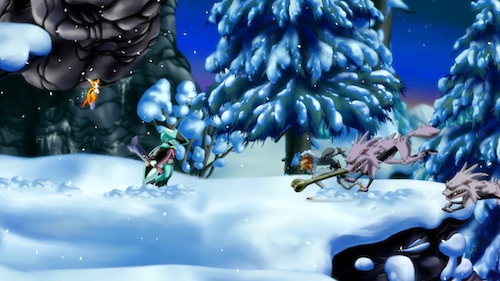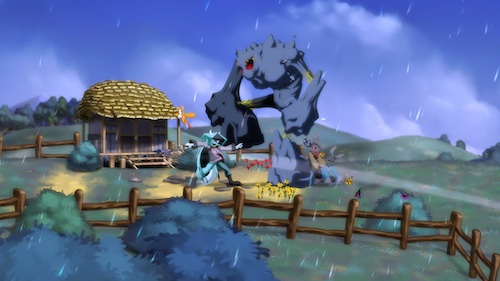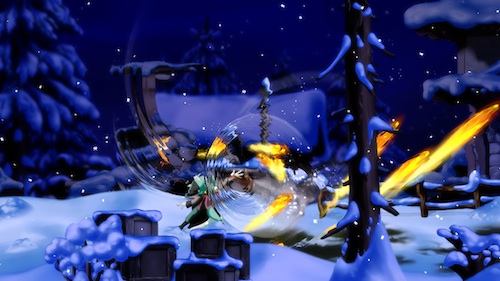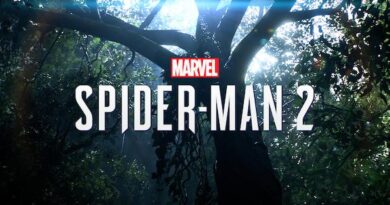Dust: An Elysian Tail, XBLA Guest Review
Kiwi ex-pat Chris Leggett takes a retro-esque spin through time with the product of a modern bedroom developer.
 It’s funny how, every now and then, a new IP can evoke feelings of nostalgia. As game design marches in new directions, leaving those classic, formative styles in the dust, some developers opt to revisit and tweak the winning formulas of old.
It’s funny how, every now and then, a new IP can evoke feelings of nostalgia. As game design marches in new directions, leaving those classic, formative styles in the dust, some developers opt to revisit and tweak the winning formulas of old.
This is true of Humble Hearts (essentially one man by the name of Dean Dodrill) and its recent XBLA game, Dust: An Elysian Tail, which layers contemporary gameplay elements atop an old-school, Metroidvania foundation to mixed results.
It’s set in the bizarre world of Elysium, an anthropomorphic – animal fantasyland, the inhabitants of which draw inescapable comparisons to the “furry” visual style. Players assume the role of Dust, a young samurai-esque warrior suffering from amnesia who takes it upon himself to find the cause of the monster hostility that’s consuming Elysium. What begins as a seemingly throwaway story with forgettable characters begins to strike a chord partway through Dust’s 15-odd hours of gameplay. Eventually, you develop a surprising understanding and even an attachment to its world and its denizens. At its best, the plight of some characters will tug at the player’s heartstrings mere minutes after first meeting them, which speaks to the game’s at-times masterful delivery. The design of Dust’s sidekick, Fidget, is questionable, and weird in a sense that I couldn’t shake for the game’s duration. She’s a small, winged, fox-like character with, erm,… curvaceous thighs that are at odds with a design that seems otherwise designed to appeal to children. Another companion comes in the guise of Dust’s talking sword, Ahrah, and the game’s plot is largely delivered through the interaction of these three core characters.
 However, the pacing of Dust is such that the game takes a fair while – hours, even – to hit its stride. Admirably, it refrains from revealing all of its best tricks early in the piece. But this approach, front-heavy in monotony and repetition, also runs the risk of losing lesser-invested players. After the first hour or so, progress began to feel like a chore. But when it all does fall into place roughly a third to midway through the game, a charmingly delivered story and a surprisingly engaging gameplay formula surface.
However, the pacing of Dust is such that the game takes a fair while – hours, even – to hit its stride. Admirably, it refrains from revealing all of its best tricks early in the piece. But this approach, front-heavy in monotony and repetition, also runs the risk of losing lesser-invested players. After the first hour or so, progress began to feel like a chore. But when it all does fall into place roughly a third to midway through the game, a charmingly delivered story and a surprisingly engaging gameplay formula surface.
Immediately striking about Dust is its art style, which channels the cartoon-fantasy style of Mega Drive/Genesis-era side-scrollers, amplified with the grunt that modern hardware affords. The hand-painted environments of Dust are saturated with bright colours, and its character animation is as smooth as silk. The fact that all of it was painstakingly crafted by Dodrill himself only serves to make it all the more impressive. However, he did enlist the talents of HyperDuck Soundworks for the game’s fantastic soundtrack, ensuring that Dust is a professional package in every respect.
 Another of Dust’s strengths is its combat mechanic: a hack-‘n’-slash, button-mash affair that draws inescapable parallels to the fast-paced, frenetic action of the Marvel vs. Capcom series. Impressively, although it may appear otherwise to the passive observer, it’s not all mindless mashing. There’s certainly a method to this madness, with combinations coming together in a satisfying, surprisingly intuitive and almost subconscious fashion.
Another of Dust’s strengths is its combat mechanic: a hack-‘n’-slash, button-mash affair that draws inescapable parallels to the fast-paced, frenetic action of the Marvel vs. Capcom series. Impressively, although it may appear otherwise to the passive observer, it’s not all mindless mashing. There’s certainly a method to this madness, with combinations coming together in a satisfying, surprisingly intuitive and almost subconscious fashion.
There are light RPG elements present, but they’re mostly token in implementation. As Dust levels up, he’ll earn skill points that the player can distribute between four attributes. And while all early points can be invested into, say, the “attack” attribute to enhance damage against enemies, players will eventually max out almost all attributes, which results in a near-homogenous character build. There are items and armour that can augment Dust’s abilities, but they don’t cause anything particularly dramatic or noticeable.
Upon reaching the first major village, the player will be inundated with fetch quests; chiefly from villagers who lost something important in the panic of the monster attacks. It’s an interesting addition to an action platformer, but one that’s generally lost on this type of game. The flood of dialogue as the various villagers brings the game to a screeching halt, and completing the quests demands an undesirable amount of backtracking. However, if you’re that way inclined, then there’s plenty to keep you occupied in Dust. The curious and exploratory will uncover these items as the game progresses, along with treasure chests opened via a timed mini-game. Many, however, can only be reached once the player has acquired certain abilities (in keeping with the classic Metroidvania gameplay) or mastery of the game’s floating explosives. Gold acquired throughout the adventure is used to acquire items (from energy-replenishing food to armour to weapon augments).
 A word of advice: take the time to complete a few sidequests before plowing on through to the finale. The game’s tail end represents a fairly dramatic difficulty spike, with sometimes lengthy periods between checkpoints. Add to this a final boss that’s controller-throwingly difficult for the under-leveled character – a lengthy duel that can end in the blink of an eye thanks to a wide-reaching, one-hit-kill maneuver – and you’ll potentially save yourself some heartache.
A word of advice: take the time to complete a few sidequests before plowing on through to the finale. The game’s tail end represents a fairly dramatic difficulty spike, with sometimes lengthy periods between checkpoints. Add to this a final boss that’s controller-throwingly difficult for the under-leveled character – a lengthy duel that can end in the blink of an eye thanks to a wide-reaching, one-hit-kill maneuver – and you’ll potentially save yourself some heartache.

Dust’s biggest problem – its slow-build pacing – could bore a lot of players into giving up before the wave crests. And that’s a crying shame, as the game’s second half is where it truly spreads its wings. There’s a lot of game crammed into this XBLA package; an impressive blend of classically styled action platforming that’s supplemented by gameplay innovations learned over the past two decades.




